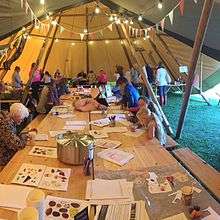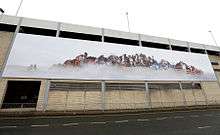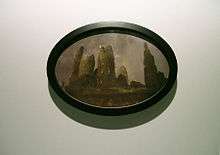Gayle Chong Kwan
| Gayle Chong Kwan | |
|---|---|
 Gayle Chong Kwan by Georgia Kuhn, 2013 | |
| Born |
1973 (age 43–44) Edinburgh, Scotland |
| Known for | Photography, Visual Arts |
Gayle Chong Kwan (born 1973) is a London-based artist whose large-scale photographic, installation, and video work has been exhibited and published internationally.
Life and work
Education
Chong Kwan is a Research Candidate in Fine Art at the Royal College of Art,[1] London, (2012-). She holds a BA Hons Politics and Modern History, University of Manchester (1994), where she specialised in Post-Colonial Politics in Sub-Saharan Africa; an MSc in Communications, University of Stirling (1995); and a BA Hons Fine Art, Central Saint Martins College of Art and Design (2000).
Artwork
Gayle Chong Kwan is a British artist who is known for her large-scale mise-en-scene environments and photographs, created out of waste products, found materials and documentary sources, and which are often sited in the public realm.[2] Her work highlights the ambiguous relationship between reality, appropriation, fictional contemporary mechanisms, and latter day myths and has focused on contemporary developments in tourism, trade and development in relation to their impact upon the landscape.[3] Chong Kwan develops her work through a process which can involve sensory activities, participation, and historical or archaeological inquiry, to create settings or props through which more fantastical modes of phenomenological experience or re-visioning can take place.[4]
Selected works

The Pan Hag, Easington Nature Reserve, East Durham, commissioned by Forma (2015–2016), was an outdoor event, inviting the public to explore the lost and overlooked traditional skills and customs related to crafts, growing, food and nature.[5] Local enthusiasts worked with Gayle Chong Kwan to lead activities and workshops including peg looming, proggy mat making, woodturning demonstrations, recipe tasting, sea glass collecting, creative nature walks, and art and craft sessions. Visitors were also invited to cast their vote at the world's first Pan Hag Championship.[6] The Pan Hag takes its name from the regional dish of pan haggerty, or panacultym amongst other names – a favourite amongst miners – and is the culmination of two years of research, events, and activities by Chong Kwan in East Durham. A printed legacy, The Pan Hag Map, will be available from early 2017.[7]
Anthropo-scene, Bloomberg Space, London (2015).[8] Multi-layered installation that explores the built environment, strata and waste, in relation to the City of London. Fantastical large wall-based photographic panoramas are created from London’s lost buildings and contemporary waste. Installations in the gallery recall stacks of archaeological drawers. The photographic and sculptural elements range in ratio and scale. Chong Kwan brings together contemporary, historic and archaeological objects and materials, juxtaposing excavation and construction, ruin and renewal, and confounding their chronology in order to question what we leave to posterity.[9]

Arripare (2013) is a 40 metre long photographic vinyl print, which is installed on the side of Castlegate shopping centre in Stockton-on-Tees,[10] developed by Chong Kwan as recipient of the inaugural Refocus Prize.[11][12] The work depicts an alternative version of Stockton as an island, combining photography, collage and sculpture.[13]

Wastescape (2012), was commissioned by the Southbank Centre, London, for the Festival of the World.[14] Chong Kwan used thousands of discarded and used plastic bottles and food packaging to transform an under-served space at the top of the Queen Elizabeth Hall into a cavernous immersive 'Wastescape'. Oral histories from both Moravia and London bring these communities to life, with sound weaving through the space.[15]
Memory Trace (2012), commissioned by the Wellcome Trust,[16] and installed the length of the windows at the front of their headquarters on Euston Road, London, is a photographic landscape of London sculpted from drawings of the brain from different times in history, and featuring landmarks used by taxi drivers as navigational points, the work links the capital's urban topography with pathways created in our memory, whilst referring to how the hippocampus grows in the brains of London taxi drivers in order to accommodate in-depth experiential and relational spatial knowledge. At night the landscape fades into silhouette and LED lights bring the spatial journeys and neural pathways to the fore.[17]

The Obsidian Isle (2011) is a series of photographs, sculpture, publication and map, which document a fictional island, on which exist the lost and destroyed buildings and places of Scotland, and refers to a controversial literary work. Ossian, the blind 3rd century poet who was ‘discovered’ by James Macpherson in the 18th Century. Dominic Paterson wrote of the work: “Gayle Chong Kwan’s fictional realm The Obsidian Isle, a chimera made up of lost realities and fake pasts, delights in precisely the kinds of confusion between fact and fiction that Schalansky so concisely describes. The artist presents us with constructed images of a place which is part Ossianic myth, part repository of abandoned building projects, as firmly rooted in Romantic conventions for representing landscape as it is in the contemporary world of advanced photographic technology. Posited as a place where Scottish history is both remembered and forgotten, The Obsidian Isle is both fantastical illusion and a hypothetical dark mirror in which we glimpse the kinds of myth-making and historical story-telling which sustain such realities as the nation state or national identity. Chong Kwan invites us to view a place, which is an amalgam of different places: where, then, should we locate The Obsidian Isle itself? ...."[18]

Journey to the Centre of the Earth (2007) was a large-scale photographic installation, commissioned by Art on the Underground,[19] which was installed in three London Underground stations: a large-scale photographic work, Core, installed in one of the longest tunnels in London Bridge station; Hollow Earth, a large photographic wrap-around billboard around Southwark station; and Intra, two large panels of vinyl photographs installed at the entrance of Borough station. Taking its title from Jules Verne's novel of the same name that illustrates an extraordinary underground world and refers to bodily digestion and the cooking of the earth. Chong Kwan worked with participants, including station staff, catering college students, and market traders, to explore their personal and cultural culinary histories as well as that of London Underground and the capital’s gastronomic heritage.[20]
.jpg)
Cockaigne is a series of twelve c-type photographic prints, commissioned by Autograph ABP, exhibited and published internationally. The large-format photographs are based on 14th-century ideas of a glutton's paradise, Cockaigne (2004). Each photograph depicts a mythical landscape constructed from a single foodstuff, exploring the exotic in tourism, myth and fine art.[21] Chong Kwan developed the work from a residency she undertook in Mauritius, where she researched the effects of the tourist industry on the landscape of the island.[22]
Awards
- Arts Council England International Fellow (2005)
- Pépinières Européennes pour Jeunes Artistes Award (2005)
- Vauxhall Collective Photography Award (2008)
- Royal Scottish Academy Award (2013)
- Refocus: the Castlegate mima Photography Prize, Middlesbrough Institute of Modern Art (mima) and Stockton-on-Tees Borough Council (2013). A commission to produce ""Arripare"[23][24]
- 'Wandering Waste', Stills, Edinburgh, and Deveron Arts, Huntly, Royal Scottish Academy Award (2014)
- FATHOM Award, Four Corners, London (2014)
- British Council/Arts Council England International Artist Award - 'Photography in the Public Realm New York' (2015)
Teaching and education work
Chong Kwan is a visiting tutor and is invited to speak on her art practice, at symposia and run tutorials at art colleges and Universities internationally. She leads workshops and projects for galleries including V&A, London; Tate Modern, London;[25] La Villette, Paris; with diverse groups including Looked After Young People (Tate Britain); young people with severe learning difficulties (Chisenhale Gallery/Beatrice Tate School); community groups in Colombia (Moravia, Medellin 2009).[26]
Personal life
Chong Kwan was born in Edinburgh to a Scottish mother and a Chinese-Mauritian father. She lives with her two sons, Lorin (born in 2009) and Odilon (born in 2015), in Leytonstone, London.[27]
References
- ↑ "Gayle Chong Kwan". Royal College of Art. Retrieved 21 March 2014.
- ↑ "Gayle Chong Kwan". Contemporary Art Society. Retrieved 21 March 2014.
- ↑ Giusti, Giusti. "Gayle Chong Kwan’s Sensorial Universe". on the occasion of Gayle Chong Kwan’s Solo Exhibition ‘Sensorial Universe’. Galleria Uno + Uno, Milan. Retrieved 20 March 2014.
- ↑ "Gayle Chong Kwan". Still – Scotland's Centre for Photography. Retrieved 21 March 2014.
- ↑ http://www.bbc.co.uk/programmes/b06tpdnp
- ↑ http://neconnected.co.uk/tag/pan-hag-championship/
- ↑ http://eastdurhamcreates.co.uk/panhag/
- ↑ https://www.bloombergspace.com/artists/past/gayle-chong-kwan-anthropo-scene/
- ↑ http://www.timeout.com/london/art/gayle-chong-kwan-anthropo-scene
- ↑ Passant, Andy. "Gayle Chong Kwan: London-based artist inspired by contrasting landscapes of Teesside". GazetteLive. Retrieved 21 March 2014.
- ↑ "Arripare, 2013". Refocus Prize. Middlesbrough Institute of Modern Art. Retrieved 2016-11-09.
- ↑ "REFOCUS". Castelgate Shopping Centre. Archived from the original on 7 April 2014. Retrieved 21 March 2014.
- ↑ Brown, Camilla (March 2014). Gayle Chong Kwan: Arripare, 2013’. Photomonitor.
- ↑ "Southbank Centre opens Festival of the World for Diamond Jubilee weekend". Arts Council England. Retrieved 21 March 2014.
- ↑ Higgins, Declan. "The artist with bottle – Gayle Chong Kwan". PHOENIX. Retrieved 21 March 2014.
- ↑ Morley, Tim. "‘Memory Trace’ at the Wellcome Trust". Retrieved 21 March 2014.
- ↑ Deen, Adrian (2013). "Memory Trace". Art and Science Journal. Retrieved 20 March 2014.
- ↑ Paterson, Dominic (2011). "Utopia is Elsewhere: Mapping The Obsidian Isle". The Obsidian Isle.
- ↑ "Gayle Chong Kwan Journey to the Centre of the Earth". Art on the Underground. tfl.gov.uk, 2008. Retrieved 21 March 2014.
- ↑ Danby, Charles. "Gayle Chong Kwan: Underground exchanges". a-n Collections September 2008. Retrieved 20 March 2014.
- ↑ Bottigella, Cristiana (2008). "Gayle Chong Kwan – Atlantis". VERY (13): 36–37.
- ↑ Ed. Alexandra Boyd and Peter Bonnell (2009). The Grand Tour. ISBN 978-0-9558406-4-7.
- ↑ "Match, 2015". Refocus. Retrieved 7 April 2017.
- ↑ "Arripare, 2013". Refocus. Retrieved 7 April 2017.
- ↑ Cruciatti, Piero. "Michael Craig-Martin and Gayle Chong Kwan project at Tate Modern". DEMOTIX. Retrieved 21 March 2014.
- ↑ "Gayle Chong Kwan". Sport your Food. Retrieved 21 March 2014.
- ↑ Zuccotti, Paula. "Gayle Chong Kwan". Freunde von Freunden. Retrieved 18 March 2014.
External links
| Wikimedia Commons has media related to Gayle Chong Kwan. |